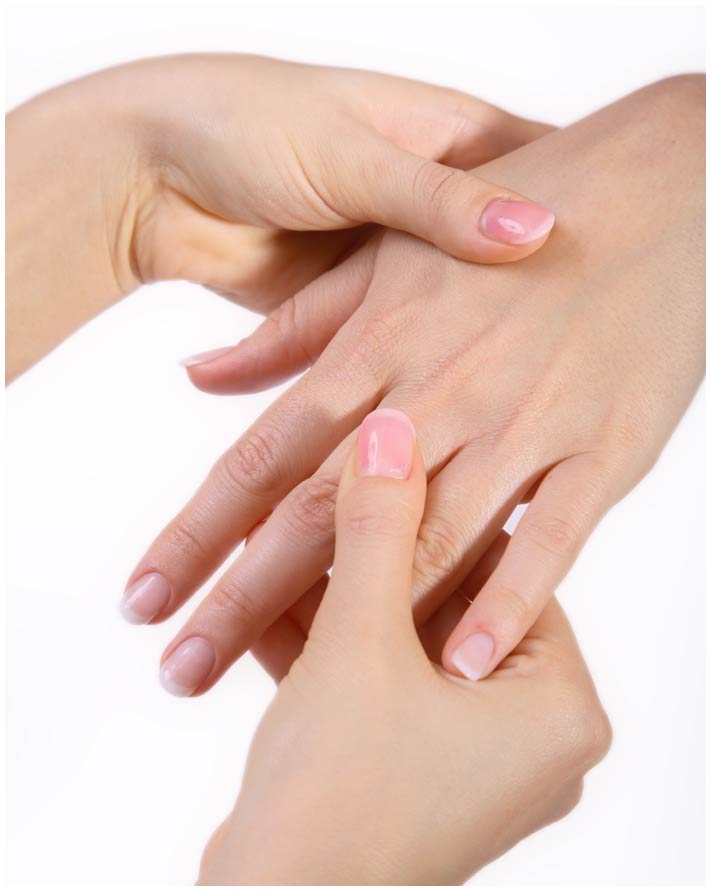Conditions We Treat
Our therapists work closely with referring physicians. Referring physicians include, but are not limited to, hand surgeons, orthopedic surgeons, plastic surgeons, rheumatologists, sports medicine physicians, occupational medicine physicians and physiatrists. Progress notes are sent regularly to the physician with each patient/physician appointment. Patients who would benefit from hand therapy services often need treatment for, but are not limited to:
Burns
Burn classified based on the severity/depth of the burn itself. Treatment will vary based on severity of the injury. Following initial first aid, care must be taken to avoid infection and stiffness of the affected area.
Carpal Tunnel Syndrome
Carpal tunnel syndrome occurs when the median nerve that runs through the forearm into the hand becomes compressed at the wrist. You may note weakness, numbness, tingling, or pain in the hand or even the forearm. Symptoms are focused in the thumb, index finger, middle finger, and ring finger. You should address the symptoms as early as possible.
Complex Regional Pain Syndrome (CRPS)
Complex regional pain syndrome (CRPS) is a pain condition that is is present over an extended period of time. Although the exact cause is unknown, it is believed to be the result of dysfunction in the central or peripheral nervous systems. The pain is out of proportion to the severity of the initial injury.
Cubital Tunnel Syndrome/Ulnar Nerve Entrapment
Cubital tunnel syndrome occurs when the ulnar nerve becomes compressed at the elbow. Symptoms are often noted when the elbow is in a bent position or leaning on the elbow. Numbness or tingling of the ring finger and small finger are common.
Dupuytren’s
Dupuytren’s disease is a slowly progressing disease that can affect the tissue in the palm of the hand. Knots of thickened tissue can cause cords to develop under the skin and may pull the fingers into a bent position. It is usually not painful but can make it difficult to perform normal day-to-day tasks.
DeQuervain’s Tendonitis
Pain on the thumb side of the wrist is associated with DeQuervain’s tendonitis. It can often be caused by overuse or repetitive motion. Pain occurs with forceful grasping or twisting and may feel sharp or dull. New mothers can develop this as they care for their newborn.
Elbow Fractures
An elbow fracture can occur with a fall, a sports injury, or impact to the elbow. If you have broken your elbow, you may experience pain and swelling around the fracture site.A sprain or dislocation of the elbow can occur with a fracture. It may be hard to move or use the arm. Medical evaluation and x-rays are usually needed as a first step to confirm the fracture.
Extensor Tendon Injuries
Injuries to the extensor tendons can range from a small tear to the tensor internally that prevents the finger from fully straightening to completely cutting the tendon. The severity of the injury with dictate the best treatment required. Extensor tendon injuries commonly occur when the finger forcibly bends, is hit with a ball, or is cut by glass, metal or a saw.
Finger Sprains
A finger sprain can occur with any use of the hand but is most commonly occurring as a result of a sports injury. Swelling may develop and it may be painful to bend, straighten or apply pressure to the finger.
Flexor Tendon Injuries
Flexor tendons are usually injured by cuts the the tendons themselves. Often, nearby nerves and/or blood vessels are cut as well.
Ganglion Cysts
The cause of cysts is unknown but tend to develop at a joint or where mechanical changes occur. The size of the cyst may change and they are usually located at the wrist or at the base of the finger. Pain is not always present when a cyst develops.
Golfer’s Elbow/Medial Epicondylitis
Golfer’s elbow (also known at medial epicondylitis) is a painful condition at the inner elbow where the muscles that bend the fingers and wrist attach to the bone and become inflamed. Repetitive activity can often be a cause of this. The inner elbow is usually painful and tender. Pain may be worse with wrist motion, rotating your forearm or with tasks that require grip.
Hand/Finger Fractures
A fracture in the hand may involve one or more fingers. If you have a broken hand, you may experience pain and swelling around the fracture site. It may be hard to move or use the hand. Medical evaluation and x-rays are usually needed as a first step to confirm if there is a fracture.
Hand Stiffness
Hand stiffness can be painful and debilitating. It may occur as a result of a previous fracture, arthritis, sprains or other injuries to the hand. There may be limited range of motion, increased swelling or discomfort with use.
Infections
There are many types of infections that can develop and affect your hand. Early treatment is key and may include antibiotics, whirlpool treatment, splinting or possibly surgery. The effects of an infection can be long lasting, leading to joint stiffness, tissue damage, and weakness of the hand.
Mallet Finger
A mallet finger occurs when the tendon that straightens your finger injured. The tendon can be torn and may even pull a small piece of bone off with it. These injuries mostly occur when the finger forcibly bends or is impacted by a ball at the tip of the finger. Following the injury, you are unable to fully straighten the finger. It may be swollen and tender to the touch.
Nerve Injuries
Nerves can be affected when there is too much pressure around the nerve, if they are overstretched or if they are lacerated. Symptoms can include tingling and numbness, pain or weakness. Common nerve injuries include carpal tunnel syndrome (median nerve) and cubital tunnel syndrome (ulnar nerve).
Numbness in the Hands
Numbness occurs when a nerve in your arm or wrist is compressed. It can occur in one or both hands. You may also experience tingling or burning pain in the hands. Because the compression can occur at various sites along the nerve, the source of compression should be assessed.
Olecranon Bursitis
The fluid filled sac at the tip of the elbow can become enlarged as a result of a fall on or impact to the elbow. This may result in pain with pressure to the tip of the elbow (i.e. leaning on the elbow).
Osteoarthritis
Osteoarthritis begins when the cartilage in a joint begins to wear away. The base of the thumb is a common problem area resulting from this wear and tear in the joint. Tasks that involve gripping and pinching can become painful and difficult. You may notice weakness and tenderness at the base of the thumb. Osteoarthritis is a degenerative disease that will worsen over time. It is best to seek care as soon as you start experiencing symptoms.
Repetitive Strain Injuries
Repetitive strain injury is a condition that causes pain as a result of a repetitive task. It is usually related to occupation but can also be caused by a hobby or activity outside of work. Symptoms can include pain, tightness, numbness and tingling.
Rheumatoid Arthritis
Rheumatoid arthritis is a chronic autoimmune disease where the body’s immune system attacks the joints rather than protecting the body. Symptoms can include stiffness, hand pain, tenderness of the joints and swelling. The joints can feel warm to the touch. Symptoms usually occur on the same joints of body sides of the body can affect joints other than those in your hands.
Scaphoid Fractures
The scaphoid is one of the small bones in your wrist that can be fractured with a fall onto the outstretched arm. A fractured scaphoid can often present similar to a wrist sprain since there is usually no deformity or swelling associated with the fracture. Pain, however, is usually present. Medical evaluation and x-rays are usually needed as a first step to confirm if there is a fracture.
Tennis Elbow/Lateral Epicondylitis
Tennis elbow (also known as lateral epicondylitis) is a painful condition at the outside of the elbow where the muscles that extend the wrist and attach to the bone become inflamed. Repetitive activity can often be a cause of this. Tasks that require gripping or lifting, especially with the elbow extended, can be painful.
Thumb Arthritis
Arthritis of the thumb joint can often lead to pain at the base of the thumb, especially with grip and pinch. People may complain of stiffness and weakness of the hand with use. There may be tenderness at the base of the thumb with pressure.
Thumb Sprains
Thumb sprain usually occur as a result of a sports injury such as impact from a ball or while skiing. It can also occur if the thumb is bent into an unnatural position. You may have pain and swelling around the affected area. Tasks that involve pinch or grip may be painful.
Traumatic Injuries
Trauma to the hand can be caused by a laceration, crush, puncture, burns, high pressure injuries, infection or amputation. Following care by a physician, therapy is helpful to regain function, reduce pain, gain motion and proper sensation.
Trigger Finger
Trigger finger occurs when the tendons that bend our fingers become inflamed and thickened and cannot properly glide along the bone. This can result in pain, tenderness, and a catching or popping feeling as you move the finger. Full motion of the finger can become difficult.
Ulnar Wrist Pain
Ulnar wrist pain is described at pain on the small finger side of the wrist. Symptoms often involve pain in this area of the wrist, popping at the wrist, tenderness at the ulnar wrist, limited motion or grip strength.
Wrist Fractures
There are 10 bones that make up the wrist and any of them can be involved when you break your wrist. The most commonly broken wrist bone is the radius. A wrist fracture often occurs with a fall, a sports injury, or a car accident. If you have broken your wrist, you may experience pain and swelling around the fracture site and it may look deformed in shape. It may be hard to move or use the hand or wrist. Medical evaluation and x-rays are usually needed as a first step to confirm the fracture.
Wrist Sprains
A sprained wrist may involve any of the many ligaments that are present in the wrist. Most commonly, the scapholunate ligament is injured. Sprains usually occur as a result of a fall on the wrist and can be painful and swollen following injury.
Schedule Your Appointment
Call Meridian Hand Therapy Today At (805) 497-1700
Hand Therapy Westlake Village
Discover the Real Benefits of Occupational Therapy
The goal in any hand therapy program is to help the patient return to a productive lifestyle. Working with a hand therapist allows patients to go beyond mere management of their condition by actively working toward a full and successful recovery. In most cases, this specialized form of occupational therapy allows individuals to resume normal function in their day-to-day activities.
Hand therapy focuses on a combination of patient education and training as well as adaptive recommendations and equipment. Patients benefit from learning about energy conservation and joint-protecting techniques. Using their years of experience, hand therapists can recommend a customized set of tools that may include simple exercises, stretches, and regimented activities to improve strength, flexibility, and overall function. Addressing pain, swelling, and wound care is another crucial component of successful treatment.

